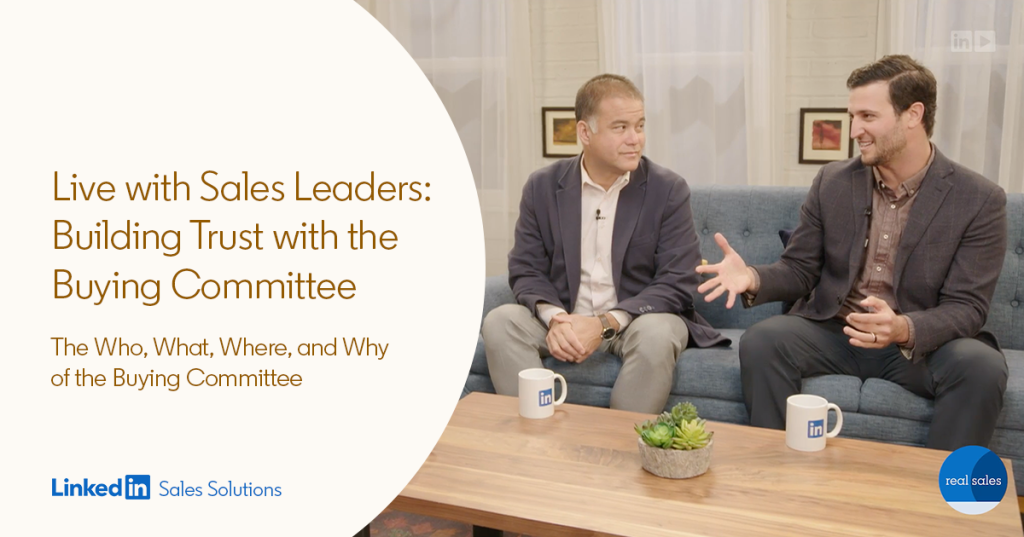What We Learned from Live with Sales Leaders: Building Trust Across the Buying Committee
We’re here to talk about a topic that intimidates even the most seasoned sales reps: how to build trust in the buying committee. In this episode of “Live with Sales Leaders,” LinkedIn’s Vidya Drego, Group Manager - Product Marketing, was joined by Craig Rosenberg, Chief Analyst and Co-founder, and Dan Gottlieb, Analyst - Sales Development Practice, from TOPO. Together, they discuss the current state of the buying committee, how to handle new relationships vs. existing relationships, and what are some tools & tactics that sales reps can add to their arsenal when it comes to building trust.
There was so much great discussion packed in this episode that we’ve decided to split this “Live with Sales Leaders” recap into a 3-part series. The first installment focuses on the four W’s of the Buying Committee: Who, What, Where, and Why.
Before Figuring Out Who’s on the Buying Committee, Visualize the Deal First
Kicking the show off, Drego asked about what best practices were in terms of defining roles in the buying committee and how to identify the right players and opportunities.
But before we can even ask who should be on the committee, we need to take a step back to see how many threads tie into the entire sales process. By seeing who historically is attached to these threads, we can dive deeper and start asking, “What do they care about? In what order do they care about them, and what do I need to talk to them about in order to make this progress?”
This line of questioning will ideally yield a multithreaded stakeholder plan that will help you build a vocabulary around who they talk to and when. If you can create a vocabulary around the entry point threads and define how you are supposed to talk to them (not just the messaging), you can also figure out where and how to use Conversation A for conversation B.
Gottlieb gives an excellent example:
“Say you have a client that sells manufacturing and ERP software to manufacturing companies. It’s a very intense long sales cycles and you’ve talked to every street-smart SDR – there's this whole list of people that they have to go talk to. It takes a month to develop an opportunity because they have to talk to all these people.
If you can capture that and call it what it is, define that. That's a really important part of the strategy so that everybody knows who and why you're talking to them, and what the expectations are for how you're actually going to hand off an opportunity when it comes up.”
Let’s Talk Buckets
Because it’s tough to keep track of multiple stakeholders at once, so you’ll want to group specific titleholders into buckets. Rosenberg says it’s less about the number of buckets you will create, and more about considering how each bucket fits into your sales strategy.
There are your champions, the practitioners who buy for pain, the execs who buy for ideas and upside – and then there are the people you want to talk to but don’t have a connection with yet. This is when you want to start engaging with them longterm and digitally, Rosenberg emphasizes. You don’t have to talk to these points of contact, but you want to establish some degree of engagement for when you do begin to leverage that connection.
After you’ve sufficiently schmoozed with the champions and decision-makers, you might be feeling in a pretty good spot. But don’t let your guard down – the deal isn’t done yet, and you’re rapidly approaching a looming hurdle. Gottlieb has an excellent strategy for dealing with that dreaded “Bowser-esque” bucket – the Procurement Black Hole.
“A lot of companies will actually try to play offense on that, and we'll try to say, ‘Hey, can I meet with these people now when they go onsite? Can I just drop by procurement's desks?’ I've heard stories of sales reps who do that so that when Bowser shows up, you are able to get things done much faster because of those kinds of little decisions that they make.”
In the end, it really doesn’t matter if you got the chance to talk to everyone in the buying committee. What matters is being able to consider and engage each bucket in order to successfully push through the sales cycle.
Two things about buckets:
Rosenberg first wants to impress upon the importance of the entry point since that person is always going to be interested in your company’s output, whether that be product betas, webinars, or conferences. The entry point, or champion, may or may not be able to move the deal, but at the very least you have someone in your corner.
Secondly, establishing who’s on the buying committee does not mean you have to talk to everyone. There are other ways of building trust beyond getting that decision-maker to hop onto the phone with you. Don’t make engaging with stakeholders harder than it needs to be.
The Secret to Multi-threading
One of the worst feelings sales reps can experience is when deals they’ve been working on for months suddenly go dark. Their linchpin has suddenly left, and now they don’t have anyone else in the buying committee to help them bring the deal home.
When the darkness comes, Rosenberg states, it’s usually because of two use cases:
- The deal was too rushed; the sales rep was too eager to pitch as hard as they could, but weren’t giving the buying committee enough space to have the conversation it really wanted.
- The deal had no sense of urgency; the sale rep didn’t attempt to stay relevant and provide more value for their prospects throughout the deal.
This is why multi-threading, or building multiple relationships within the buying committee, pays off in spades when done correctly. Because you’ve already figured out what’s relevant for the members you don’t have relationships with (since you’re following Rosenberg’s tip about engaging buckets), you can use your arsenal of conversation topics, e-books, case studies, etc. to start building those relationships. Get creative when it comes to showing value, like setting up a meeting to show off that custom report you built for the prospect. Stop thinking everything has to be about scheduling the demo.
Once you’ve multithreaded successfully, you’ll have to worry much less about the deal going dark because now there are multiple stakeholders that you can reach out to in a pinch. We’ll say over and over again – real relationships are at the heart of real sales, and cultivating long-term relationships with these stakeholders will go a long way in building trust for the current deal, and the next deal, and the next…
Topics: Sales enablement
Related articles






